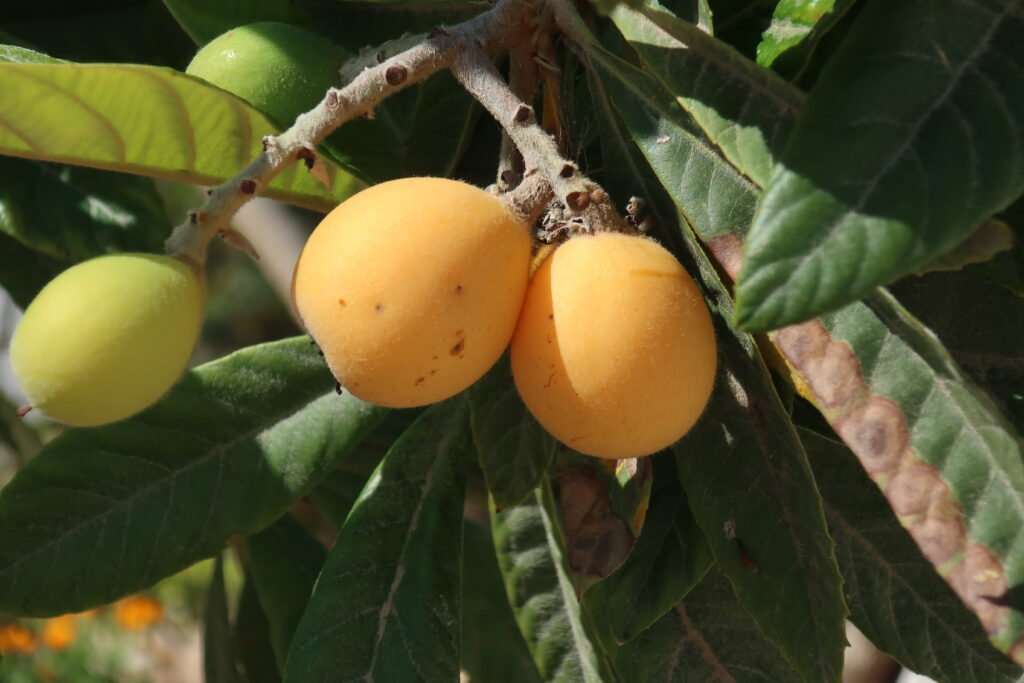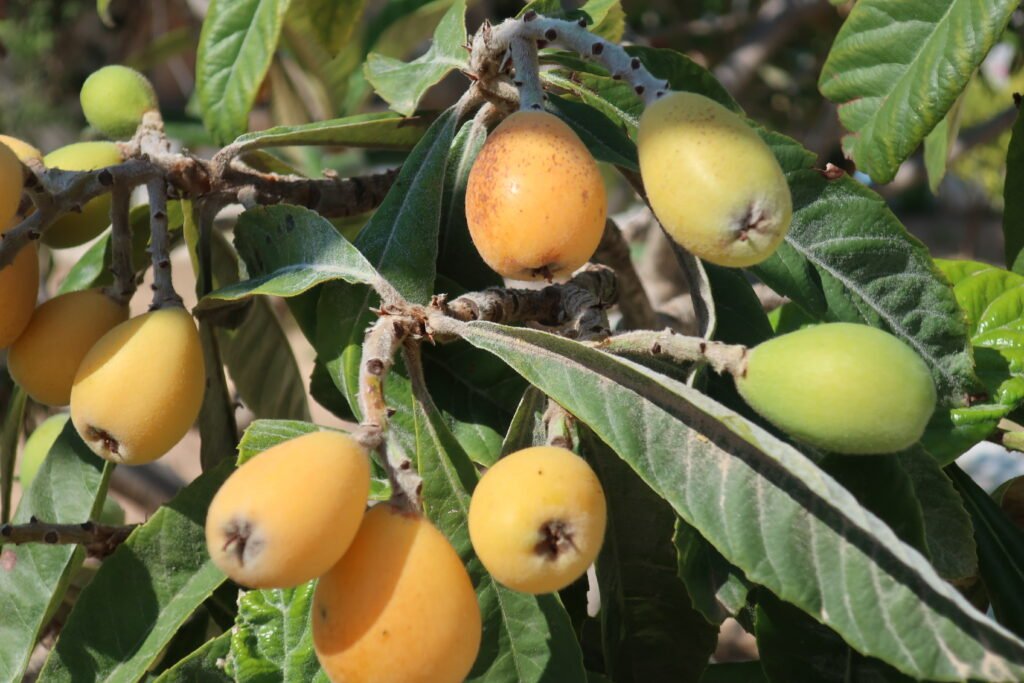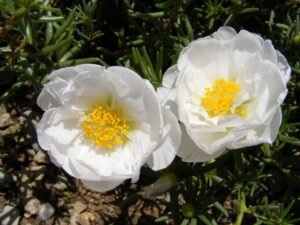How To Plant, Grow, And Care For Loquat Tree

Loquat Tree Fruiting
The loquat tree, also known as Eriobotrya japonica, is a beautiful evergreen and fruit-bearing tree or shrub that is native to China. The loquat tree have some other common names like Japanese medlar, Japanese plum and Chinese plum. It is prized for its delicious and nutritious fruit, as well as its attractive foliage and flowers. This article explains in detail how to plant, grow, harvest and care for Loquat Tree.

The loquat tree belongs to the Rosaceae family, which includes other fruit-bearing trees like apples and pears. The loquat tree can reach a height of up to 30 feet and has large, glossy leaves that add a touch of tropical beauty to any landscape.
Facts About Loquat Tree
Loquat trees are native to southeastern China, specifically in the provinces of Zhejiang, Fujian, and Guangdong. They have been cultivated in this region for over a thousand years. Today, loquat trees can be found in various parts of the world, including Japan, India, Brazil, the United States, and Mediterranean countries.
A mature loquat tree can reach a height of 10 to 30 feet, with a spread of about the same size. The tree has large, dark green, and glossy leaves that are about 5 to 12 inches long. The flowers of the loquat tree are small, white, and fragrant, attracting bees and other pollinators.
Loquat trees are known for their ability to adapt to different climates and soil conditions. They are considered hardy trees and can tolerate temperatures as low as 10°F (-12°C). However, they thrive best in subtropical and mild temperate regions with well-drained soil.
One of the main reasons why loquat trees are cultivated is for their delicious fruit. The fruit is round or pear-shaped, with a thin, orange to yellow skin. The flesh is juicy, sweet, and slightly acidic, similar to a combination of peach, citrus, and mango flavors.
Loquats are not only tasty but also packed with essential nutrients. They are a good source of vitamin A, vitamin C, potassium, and dietary fiber. The fruit is a nutritious snack choice because it is low in fat and calories.
Aside from their delicious fruit and medicinal benefits, loquat trees are also prized for their ornamental value. The tree’s large, glossy leaves and attractive flowers make it a beautiful addition to any garden or landscape. Some varieties even have variegated leaves, adding a touch of color and visual interest.
Loquat trees are often planted as shade trees or as a windbreak. They can also be trained into an attractive hedge or espaliered against a wall. Their ability to thrive in containers makes them suitable for urban gardening and smaller spaces.
Loquat trees offer several environmental benefits. Their dense foliage provides shade, which helps lower the temperature in urban areas and reduces the need for air conditioning. The trees also act as a natural filter, trapping dust and pollutants from the air.
Furthermore, loquat trees are known for their ability to attract birds, bees, and butterflies. The flowers provide nectar for pollinators, while the fruit serves as a food source for birds and other wildlife. By planting loquat trees, you can contribute to the biodiversity and ecological balance of your surroundings.
FAQ About Loquat Tree
How tall does a loquat tree grow?
Loquat trees can grow to be quite tall, reaching heights of up to 25 feet. Nonetheless, frequent upkeep and pruning can help regulate their size. It is common for loquat trees to be around 10 to 15 feet tall when grown in a backyard or garden setting.
What are the ideal growing conditions for a loquat tree?
Loquat trees thrive in warm and subtropical climates. They prefer full sun exposure for at least six hours a day, although they can tolerate partial shade. Loquat trees are adaptable to a variety of soil types but prefer well-draining soil. They are also relatively drought-tolerant once established.
How long does a loquat tree take to fruit?
Once the loquat tree has reached a certain level of maturity, typically around 2 to 3 years old, it will begin to produce flowers. The flowers of a loquat tree are small and white, and they appear in clusters. The timing of flowering can vary depending on factors such as climate, growing conditions, and the specific variety of loquat tree.
After the flowers have been pollinated, the loquat tree will start to develop fruit. The fruit begins as small green berries and gradually grows larger and changes color as it matures. The time it takes for the fruit to fully develop and ripen can vary, but it generally ranges from 4 to 6 months.
When do loquat trees bear fruit?
Loquat trees typically bear fruit in late winter or early spring, depending on the climate. The exact timing may vary depending on the specific location and growing conditions. The fruits generally take around 90 to 120 days to ripen after the flowers have been pollinated.
Is it possible to grow a loquat tree in a container?
Yes, loquat trees can be grown in containers, making them suitable for small spaces or areas with colder climates. Choose a dwarf or compact variety that is suitable for container cultivation. Make sure the container drains well, and give it frequent fertilizer and watering. To manage the tree’s size and shape, prune it as necessary.
Right Location For Loquat Tree
Before you plant your loquat tree, it is important to choose the right location. Loquat trees thrive in full sun, so look for a spot in your garden that receives at least 6-8 hours of direct sunlight each day. Additionally, loquat trees prefer well-draining soil, so make sure the area you choose has good drainage.
Loquat trees can tolerate a range of soil types, but they prefer slightly acidic to neutral soil with a pH level between 6.0 and 7.5. You can adjust your soil by adding organic matter, such as compost or well-rotted manure, if it is excessively alkaline.
How To Plant Loquat Tree
Once you have chosen the perfect location, it’s time to plant your loquat tree. Follow these steps to ensure a successful planting:
Step 1: Digging the Hole
Start by digging a hole that is slightly larger and deeper than the root ball of your loquat tree. The roots will have enough of space to grow and become established as a result.
Step 2: Preparing the Soil
Loquat trees prefer soil that is rich in organic matter, so mix some compost or well-rotted manure into the soil that you removed from the hole. This will provide the tree with essential nutrients and help improve drainage.
Step 3: Planting the Tree
Place the loquat tree in the hole, making sure that the top of the root ball is level with or slightly above the surrounding soil. Backfill the hole with the amended soil, gently firming it around the roots as you go. Over compaction of the soil should be avoided since it can impede root development.
Step 4: Watering
After planting, give your loquat tree a thorough watering to help settle the soil and eliminate any air pockets around the roots. Keep the soil evenly moist, but not waterlogged, during the first few weeks after planting to help the tree establish itself.
How To Care For Loquat Tree
Once your loquat tree is planted, it’s important to provide it with the proper care to ensure its health and productivity. Here are some tips for caring for your loquat tree:
Watering
Before we dive into the specifics of watering your loquat tree, it’s important to understand its watering needs. Loquat trees are native to subtropical regions and are adapted to a Mediterranean climate. This means that they prefer a moderate amount of water and can tolerate some drought conditions.
Overwatering can be detrimental to the health of your loquat tree, as it can lead to root rot and other fungal diseases. On the other hand, underwatering can cause stress to the tree and result in stunted growth and poor fruit production. Finding the right balance is key.
The frequency of watering your loquat tree will depend on several factors, including the climate, soil type, and age of the tree. In general, newly planted loquat trees will require more frequent watering compared to established ones.
During the first year after planting, it is important to keep the soil consistently moist. This means watering your loquat tree about once or twice a week, depending on the weather conditions. However, be cautious not to overwater, as this can lead to waterlogged soil and root rot.
Once your loquat tree is established, you can reduce the frequency of watering. In general, watering every 10-14 days should be sufficient. However, it’s important to monitor the moisture level of the soil and adjust accordingly. Loquat trees prefer slightly moist soil, but they can tolerate short periods of drought.
Deep watering is a technique that involves saturating the soil around the roots of the tree. As a result, the tree becomes more drought-tolerant as its roots spread farther into the ground.
To deep water your loquat tree, use a hose or a drip irrigation system and water the area around the tree slowly and deeply. Make sure to water beyond the drip line, as this is where the majority of the roots are located. Aim to provide enough water to penetrate at least 12-18 inches into the soil.
Fertilizing
Fertilizer is an essential component of any successful gardening or farming endeavor, and loquat trees are no exception. Fertilizer provides the necessary nutrients that the tree needs to grow, develop healthy foliage, and produce abundant fruit. Without proper fertilization, loquat trees may become weak, susceptible to diseases, and produce fewer fruits.
Loquat trees have specific nutrient requirements, and a well-balanced fertilizer can help meet those needs. The three main nutrients that are essential for loquat trees are nitrogen (N), phosphorus (P), and potassium (K). Nitrogen promotes healthy leaf and stem growth, phosphorus supports root development and flowering, and potassium enhances fruit quality and overall tree health.
Next, you’ll want to look at the NPK ratio on the fertilizer packaging. The percentage of nitrogen (N), phosphorus (P), and potassium (K) in the fertilizer is indicated by the NPK ratio. For loquat trees, a balanced fertilizer with an NPK ratio of 10-10-10 or 14-14-14 is generally recommended.
In addition to the NPK ratio, you may also want to consider using an organic fertilizer for your loquat tree. Organic fertilizers like compost and vermicompost are made from natural sources and can provide slow-release nutrients to the tree. They also improve soil health and promote beneficial microbial activity.
After applying the fertilizer, it’s important to water your loquat tree thoroughly. This will help the nutrients penetrate the soil and reach the tree’s roots. Watering immediately after fertilizing will also prevent the fertilizer from burning the tree’s roots.
Avoid fertilizing in late summer or fall, as this can stimulate new growth that may be damaged by frost.
Pruning
Pruning is an important part of loquat tree care, as it helps maintain the tree’s shape, promotes airflow, and removes dead or diseased branches. Prune your loquat tree in late winter or early spring, before new growth begins. Remove any crossing or rubbing branches, as well as any branches that are growing towards the center of the tree.
Pest and Disease Control
Loquat trees are generally resistant to pests and diseases, but they can occasionally be affected by aphids, scale insects, or fungal diseases. Monitor your tree regularly for any signs of pests or diseases, such as distorted leaves, sticky residue, or black spots. If necessary, treat the problem with an appropriate insecticide or fungicide, following the instructions on the product label.
Winter Care
Winter care is crucial for the health and well-being of your loquat tree. While loquat trees are generally hardy and can tolerate cold temperatures, they still require some attention and care during the winter months to ensure they survive and thrive. In this blog post, we will discuss some important tips and guidelines for winter care of your loquat tree.
Frost can be damaging to loquat trees, especially young or newly planted ones. To protect your loquat tree from frost, you can take the following measures:
- Wrap the trunk of the tree with burlap or a frost blanket to provide insulation.
- Cover the entire tree with a frost cloth or blanket on nights when frost is expected.
- Use a portable heater or heat lamp near the tree to provide additional warmth.
Mulching is an important practice for winter care of loquat trees. Mulch helps to insulate the soil, retain moisture, and protect the roots from extreme temperature fluctuations. Here’s how you can mulch your loquat tree:
- Spread a layer of organic mulch, such as wood chips or straw, around the base of the tree.
- Ensure that the mulch is about 2-4 inches thick, but keep it away from the trunk to prevent rot or disease.
- Replenish the mulch as needed throughout the winter to maintain the desired thickness.
Harvesting Your Loquat Tree
One of the most exciting parts of growing a loquat tree is harvesting the delicious fruit. Here are some tips for harvesting your loquats:
Timing
Loquats are typically ready for harvest in late winter or early spring, depending on your climate. The fruit should be fully colored and slightly soft to the touch when it is ready to be picked. Avoid harvesting the fruit too early, as it may not ripen properly off the tree.
Harvesting
To harvest your loquats, simply twist or gently pull the fruit from the tree. The fruit is delicate, so handle it with care to avoid bruising. If you have a large harvest, you can store the fruit in the refrigerator for up to two weeks.
Enjoying Your Loquats
Loquats can be enjoyed fresh, added to fruit salads, or used in a variety of recipes. They have a sweet and tangy flavor that is reminiscent of a combination of peach, citrus, and mango. Experiment with different ways to enjoy your loquats and savor the unique taste of this delicious fruit.
Planting, growing, and caring for a loquat tree can be a rewarding experience. With the right location, proper care, and a little patience, you can enjoy the beauty of the loquat tree and the delicious taste of its fruit. We hope that this guide has provided you with the information you need to successfully grow your own loquat tree. Happy gardening!





